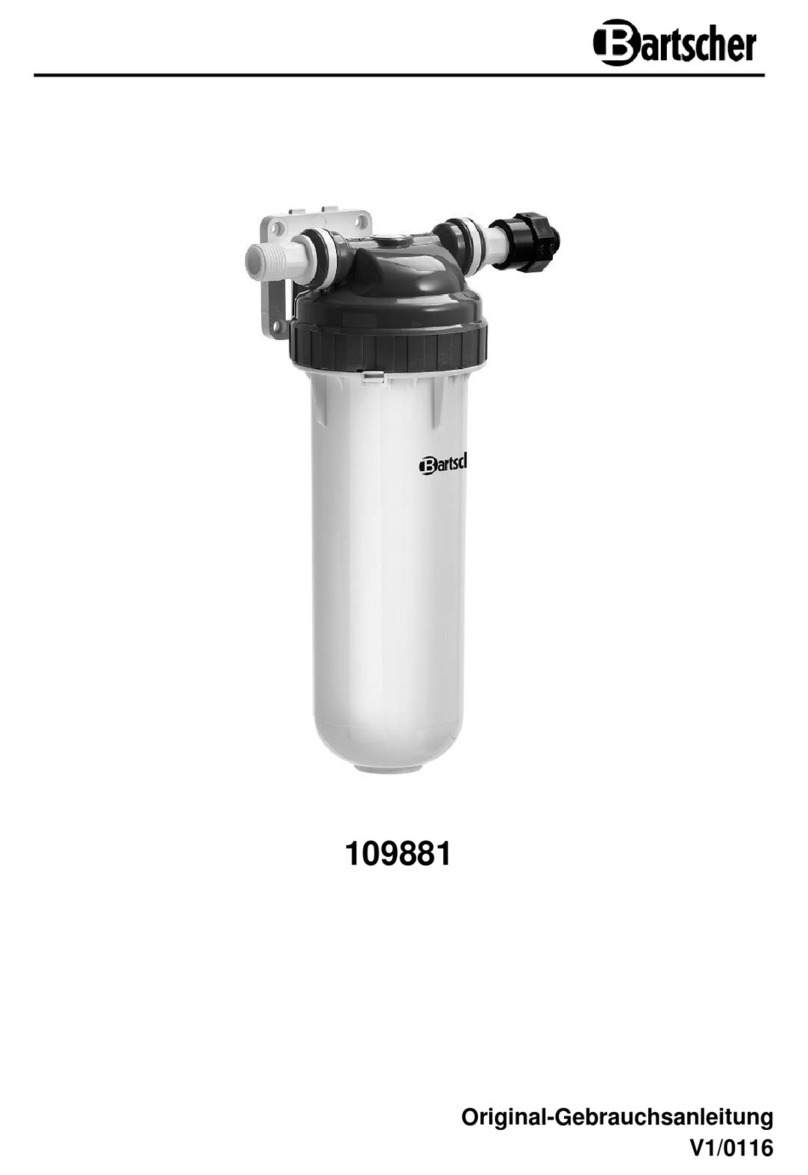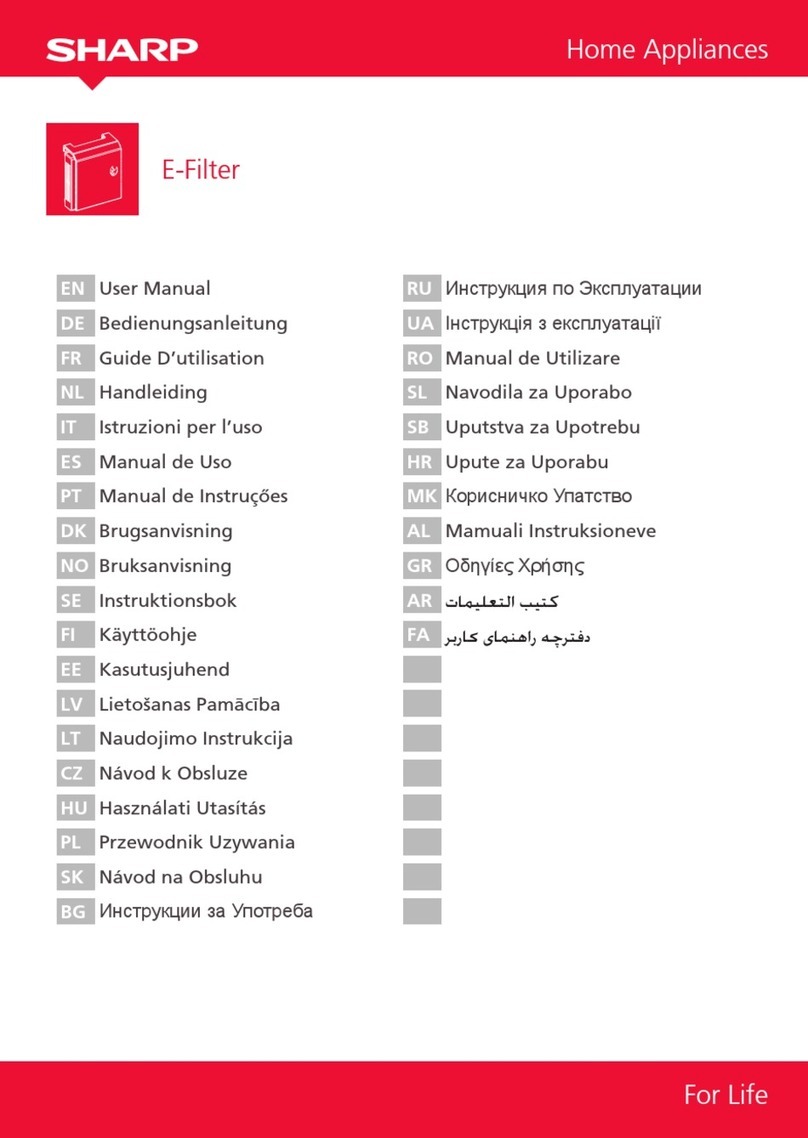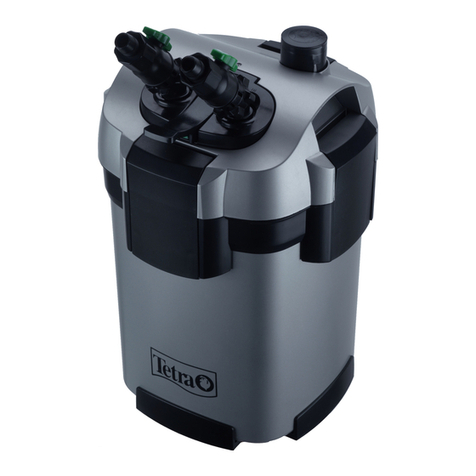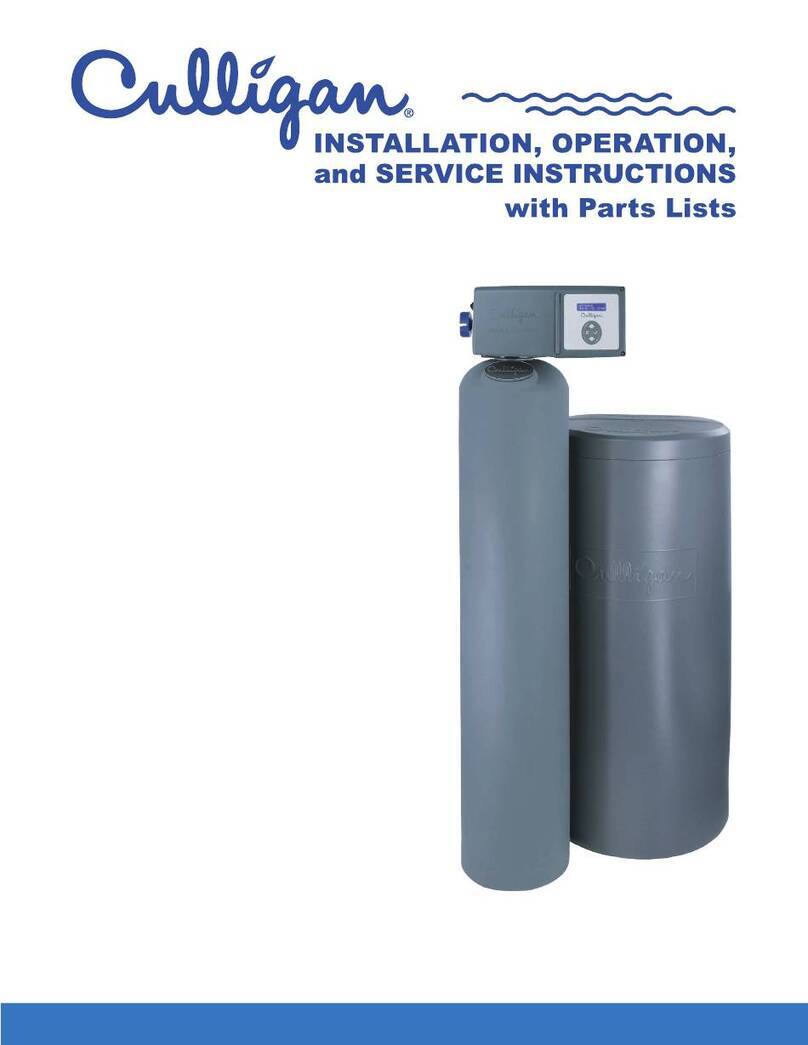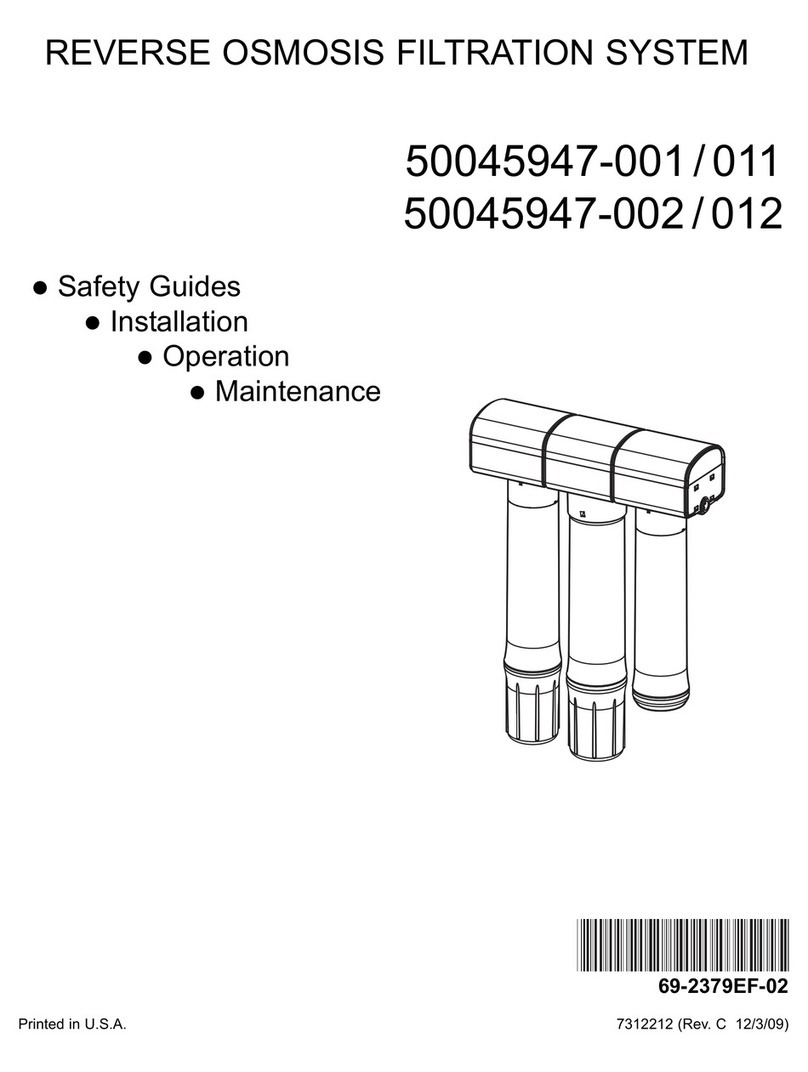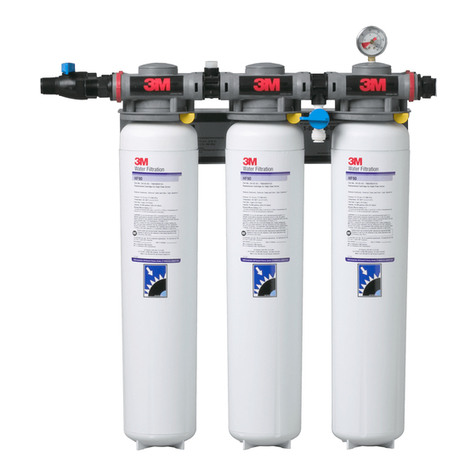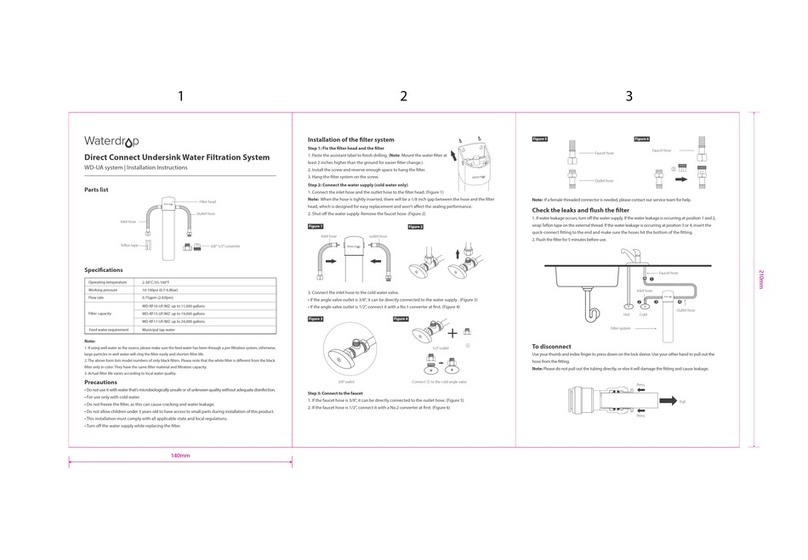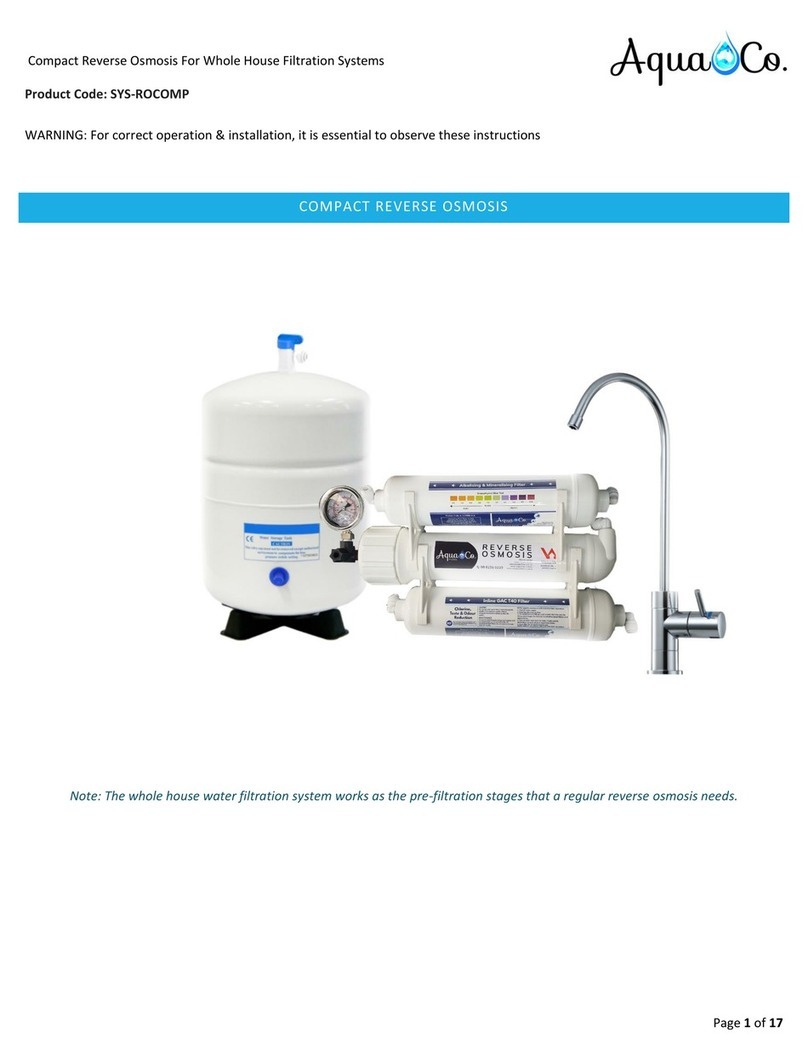Della Toffola OMNIA Series User guide

Azienda: Della Toffola S.p.A
Indirizzo: Via Feltrina, 72 – 31040 Signoressa di Trevignano (TV) (Italia)
Tel: +39 0423 6772
Web: www.dellatoffola.it
USE AND MAINTENANCE
INSTRUCTIONS MANUAL
OMNIA crossflow filter
OMNIA_0314R02EN-II.docx
EN


Read all the following safety
recommendations very carefully before
undertaking any action whatsoever with your
machine.
FIRST LEARN AND THEN ALWAYS FOLLOW ALL THE SAFETY
RECOMMENDATIONS
Read these safety recommendations very carefully before installing and using the machine.
Also read all the explanatory and warning signs attached to the machine itself. Make sure that they are always easy to read, replacing any damaged
or missing signs without delay.
Read this manual carefully before using the machine to make sure that you are thoroughly familiar with how it works and all the controls.
Never postpone learning this important information until you are already working with the machine.
Never allow any unauthorized persons unfamiliar with the equipment to come into the vicinity or operate the machine.
Always keep this manual readily available so that anyone taking action on the machine can refer to it.
If the machine is sold or transferred to third parties, it is compulsory to hand over all the related technical documentation, use and maintenance
EXPLANATION OF THE SYMBOLS
Several symbols are used in this manual and on the machine itself to accompany hazard warnings and safety recommendations.
These warnings and recommendations serve primarily to ensure the safety of Installers, Technicians and Operators, but also to avoid the machine
being damaged.
THIS SYMBOL IS USED TO DRAW YOUR ATTENTION TO THE RISK OF FATAL ACCIDENTS, SEVERE INJURIES AND EXTENSIVE
DAMAGE IN THE EVENT OF THE SPECIFIED SAFETY MEASURES BEING DISREGARDED.
THIS SYMBOL DRAWS ATTENTION TO RISKS OF A GENERAL NATURE.
THIS SYMBOL IS USED TO DRAW YOUR ATTENTION TO THE RISK OF FATAL ACCIDENTS, SEVERE INJURIES AND EXTENSIVE
DAMAGE IN THE EVENT OF THE SPECIFIED SAFETY MEASURES BEING DISREGARDED.
THIS SYMBOL DRAWS ATTENTION TO RISKS DERIVING FROM THE PRESENCE AND USE OF ELECTRICITY.
IMPORTANT
This word is used to identify paragraphs in the manual containing essential information concerning the machine. Read the related information
DEFINITIONS
The following are definitions of the individual and legal entities involved in handling and using the machine.
OWNWER: In this user manual, the OWNER is the legal representative of the company or body, or the individual, that purchased the
machine. The Owner is responsible for ensuring compliance with all the safety requirements specified in the present manual
and in the current legislation in the country where the machine is installed. This last aspect is waived if the Owner appoints a
plant MANAGER, who thus takes responsibility for implementing the safety recommendations and for compliance with the
safety standards relating to the use of the machine and relations with the OPERATOR.
INSTALLER: In this user manual, the INSTALLER is the legal representative of the company appointed by the OWNER to install and connect
the machine to the hydraulic, electrical and compressed air supply networks (etc.) at the plant. The Installer is responsible for
correctly handling and installing the machine in compliance with the recommendations of this manual and with the current legal
requirements in the country where the machine is used.
OPERATOR: In this user manual, the OPERATOR is the person authorized by the OWNER or MANAGER to take all action on the machine for
its usage, adjustment, control and routine servicing, as detailed in this manual (with which Operators must strictly comply,
limiting their action to the explicitly allowable procedures).
TECHNICIAN: In this user manual, the TECHNICIAN is the person directly authorized by the Manufacturer or, failing this (and entirely under the
latter's responsibility), by the Manufacturer's Dealer in the various European Community states outside Italy, to carry out all
extraordinary servicing procedures, as well as any adjustments, tests, repairs and replacements of parts proving necessary
during the working life of the machine.
GENERAL SAFETY RECOMMENDATIONS
!In unloading the machine on arrival, lifting and positioning it at the workplace, and all other handling procedures, comply scrupulously with the
recommendations of the relevant section of this manual.
EN

Pay particular attention when handling wheel-mounted machines, which have to be moved by hand once they are on the ground.
To prevent any risk of crushing, only move the machine by pushing it, never by pulling it, so that nobody can ever come to be in the path of the
machine as it moves. Anyone handling the machine must be supervised by another person uninvolved in the procedure, who shall keep a
constant watch to ensure that no obstacles or persons get in the machine's way and no other hazardous situations occur. This supervisor must
promptly alert the person moving the machine of any hazards so that the machine can be stopped immediately.
!The surface on which the machine slides, like the surface on which it is used, must meet all the essential safety requirements: it must be perfectly
horizontal and smooth, with nothing to interfere with the machine's movements. Check in advance to ensure that the whole distance to cover with
the machine meets all the above-mentioned requirements. Make sure that the sliding and supporting surfaces have a load-bearing capacity
sufficient to withstand the weight of the machine both empty and in use. Any discontinuity in the floor, e.g. expansion joints, grids and manholes,
must meet the specified requirements.
!Never, for any reason whatsoever, lift the machine by any hoisting points other than those indicated.
!Before the machine is used, it must always be immobilized using the fixing devices provided.
!The machine must be placed in an area accessible only to the OPERATORS and TECHNICIANS; failing this, it must be protected by a barrier
situated at least 2 m away from its outer edge. OPERATORS and TECHNICIANS may access the area where the machine is used providing they
are adequately clothed and equipped with the personal protective equipment specified by law (safety shoes, gloves, helmet, etc.). The
INSTALLER's personnel, or any visitors, must always be accompanied by an OPERATOR. Unauthorized personnel must never be allowed to
remain alone in the vicinity of the machine. The place of installation must be made inaccessible to children.
!OPERATORS shall restrict themselves to taking action on the machine's controls, so they must not open any of the panels, except for the one for
accessing the controls (if any).
!The INSTALLER shall restrict himself to taking action on the connections between the plant and the machine, so he must not open any panels, or
operate any controls.
!In all handling, usage, servicing or repairs on the machine, it is compulsory to comply with all current safety standards in the country where the
machine is used. This applies both to the equipment and to the operating methods adopted.
!Always disconnect the electric power supply before taking any action to install, service, repair or move the machine. This is of fundamental
importance to prevent the risk of death, severe injury and extensive damage to the plant.
!In certain stages of normal use, some of the containers comprising the machine are under pressure (e.g. the filter vessel, plenum chamber,
erosion-type dosing units, etc.). Never open such containers or remove any components connected to them before you have completely vented
said pressure. Venting must be done through the valves provided on the machine specifically for this purpose.
!Never move the machine during normal working cycles.
!Before each new working cycle, make sure that any mobile electric connections (power cords, plugs, etc.) are sound and efficient. If they show
any signs of damage, repairs must be made only by a specialized TECHNICIAN.
!Never take any action not mentioned in this manual under your own initiative.
!Connect the machine to the mains electric power supply according to the recommendations of this manual.
!Before starting the machine, check the efficiency of the earthing for the electric circuitry and machine frame or structure.
!Never use power cords of inadequate cross-section or provisional connections, not even briefly, and certainly not in the event of an emergency.
!Start the machine only after you have made sure of its perfectly safe connection to the systems providing the energy and anything else it needs to
function properly (mains electricity and water, compressed gas supply, water drainage network, etc.).
!Keep a safe distance from any mechanical parts in motion.
!Immediately report any alarms or the tripping of any automatic machine safety devices to the TECHNICIAN.
!Never manually reset the machine after an alarm or an automatic safety device has been tripped without first identifying and dealing with the
problem that caused them.
!Never remove the guards over moving parts while the machine is in operation.
!Before starting the machine, make sure all guards are correctly installed.
!Routinely perform all the scheduled servicing operations.
!Dispose of the packaging material for the machine at a suitable landfill, taking particular care over any film and plastic bags, which can expose
children to the risk of suffocation.
!Never release the processing waste deriving from the working process directly into the environment.
REGULATIONS FOR USING THE MACHINE IN THE FOODSTUFFS
SECTOR
The following considerations apply only to machines used with foodstuffs, i.e. destined to come into contact with products for human consumption:
!The machine in your possession has been designed and built to make it suitable for contact with foodstuffs, and fluids in particular. If in doubt
about the intended uses of your machine, refer to the relevant chapter in this manual.
!For logistic reasons related to the phases prior to its use (e.g. transport to the user's premises, storage in warehouses, etc.), it is impossible to
guarantee the delivery of the machine in conditions suitable to enable its immediate use without an accurate, preliminary sanitization. This is the
responsibility of the end user, who may have to comply with any established protocols, e.g. HACCP.
DEMOLITION AND DISPOSAL OF THE MACHINE
!At the end of its working life, the machine must be demolished and disposed of.

!THE MACHINE MUST ONLY BE DEMOLISHED AND DISPOSED OF BY ADEQUATELY-TRAINED AND PROPERLY-EQUIPPED PERSONNEL IN
COMPLIANCE WITH THE FOLLOWING PROCEDURE.
!1. Divide the machine into its constituent parts, separating the materials it is made of:
!mechanical parts (reducers, pump bodies, etc.);
!metal parts (structure, piping, etc.)
!electrical parts;
!rubber parts;
!plastic and synthetic parts.
!2. All resulting materials must be treated and disposed of in accordance with the legal requirements in the country where the machine is used.
!3. All components contaminated by oil and oily residues must be considered as special waste and disposed of by authorized consortiums. The
same applies to the lubricants that periodically have to be changed.
!4. In the event of the machine being placed out of commission, even only temporarily, it must be stored in an area inaccessible to children. All
circuit breakers and isolators must be segregated and disconnected.
Make a thorough check and release any built-up residual energy, e.g. liquids or gases under pressure inside containers or piping. The
machine must also be checked from the static standpoint, to eliminate the risk of any single machine parts moving unexpectedly.
!THE MANUFACTURER ACCEPTS NO LIABILITY FOR DAMAGE TO PERSONS OR PROPERTY DUE TO THE RE-USE OF SINGLE MACHINE
PARTS FOR ANY OTHER THAN THE ORIGINAL PURPOSES OR IN OTHER ASSEMBLY CONDITIONS.
INSPECTION OF THE GOODS ON RECEIPT
When it is delivered, the machine must be checked by the Customer to identify any signs of damage that it may have suffered in transit and ensure
that the machine is complete in every part, as listed on the order form.
If there are signs of damage, make an immediate note of the anomalies detected on the transport document (delivery note or CMR), adding the
wording “RECEIVED WITH RESERVE DUE TO EVIDENT DAMAGE TO THE MACHINE”. Delivery ex works includes insurance coverage for any
damage in accordance with the Italian law 450 of 22.08.1985 "Compensation limit". In the event of complaints, the Customer must be able to
produce an adequate photographic documentation of the most obvious damage.
GUARANTEE
The Manufacturer guarantees the machine for the period indicated in the order form.
The GUARANTEE consists exclusively in the replacement or repair, free of charge, of any parts acknowledged as being defective.
The GUARANTEE does not cover electrical parts.
The GUARANTEE is valid only if all installation and usage instructions have been followed (not only those stated by the Manufacturer, but also those
suggested by current practice).
The GUARANTEE becomes null and void in the event of any servicing procedures being undertaken by personnel not authorized by the
Manufacturer. If the machine alarm sounds or one of the automatic safety devices is tripped, the machine must not be reset manually until the cause
of the shutdown has been dealt with. Repeated manual resets can be sufficient reason for the Guarantee to become null and void.
The GUARANTEE is valid providing any flaws or defects are reported within eight days of their detection; moreover, the GUARANTEE takes effect
providing the use of the machine was suspended immediately after the fault was discovered.
AFTER-SALES ASSISTANCE
When requesting any information, servicing, or other services, it is essential to specify the SERIAL NUMBER of your machine.
It is impossible to provide accurate instructions or schedule servicing measures unless this information is provided.

NOTES
........................................................................................................................................................................................................................................
........................................................................................................................................................................................................................................
........................................................................................................................................................................................................................................
........................................................................................................................................................................................................................................
........................................................................................................................................................................................................................................
........................................................................................................................................................................................................................................
........................................................................................................................................................................................................................................
........................................................................................................................................................................................................................................
........................................................................................................................................................................................................................................
........................................................................................................................................................................................................................................
........................................................................................................................................................................................................................................
........................................................................................................................................................................................................................................
........................................................................................................................................................................................................................................
........................................................................................................................................................................................................................................
........................................................................................................................................................................................................................................
........................................................................................................................................................................................................................................
........................................................................................................................................................................................................................................
........................................................................................................................................................................................................................................
........................................................................................................................................................................................................................................
........................................................................................................................................................................................................................................
........................................................................................................................................................................................................................................
........................................................................................................................................................................................................................................
........................................................................................................................................................................................................................................
RECOMMENDATIONS FOR PROTECTION AGAINST FREEZING
If there is a danger of the ambient temperature dropping to 0°C / 32°F, be sure to empty any liquids (water or product to treat) from all
of the machine's hydraulic circuits to prevent ice forming in the piping and damaging parts of the machine.

Crossflow filter Pag. 2/75
CONTENTS
1GENERAL INFORMATION ...................................................................................................................... 8
1.1SCOPE OF THE USE AND MAINTENANCE INSTRUCTION MANUAL .............................................................. 8
1.2HOW TO CONSULT THIS MANUAL .................................................................................................................... 9
1.2.1NUMERATION OF FIGURES ..................................................................................................................... 9
1.2.2NUMERATION OF TABLES........................................................................................................................ 9
1.3CONSERVING THIS MANUAL........................................................................................................................... 10
1.4MANUAL REVISION METHOD .......................................................................................................................... 10
1.5ADDRESSEES ................................................................................................................................................... 10
1.6PASSWORD....................................................................................................................................................... 11
1.6.1User (Level 0) – no password required ..................................................................................................... 11
1.6.2Machine operator – Client Technician (Level 1) - User “A” (password level 1).......................................... 11
1.6.3Advanced Client Technician - (Level 2) – User “B” (password level 2)...................................................... 11
1.6.4Della Toffola Technician (Level 3) – User “DT” (password level 3) ........................................................... 11
1.7GLOSSARY AND PICTOGRAMS....................................................................................................................... 12
1.7.1GLOSSARY:.............................................................................................................................................. 12
1.7.2PICTOGRAMS REGARDING OPERATOR QUALIFICATIONS................................................................ 13
1.7.3PICTOGRAMS REGARDING SAFETY..................................................................................................... 14
2GENERAL INFORMATION .................................................................................................................... 15
2.1MANUFACTURER IDENTIFICATION DATA...................................................................................................... 15
2.2MACHINE IDENTIFICATION DATA AND NAMEPLATES.................................................................................. 15
2.2.1CE nameplate............................................................................................................................................ 15
2.2.2PED inspection plate ................................................................................................................................. 16
2.3CERTIFICATION ................................................................................................................................................ 17
2.3.1EC Statement of conformity....................................................................................................................... 17
2.4WARRANTY ....................................................................................................................................................... 17
2.4.1Centro di assistenza tecnica...................................................................................................................... 17
2.5PRELIMINARY OPERATIONS AT THE USER’S RESPONSIBILITY................................................................. 18
3SAFETY .................................................................................................................................................. 19
3.1SAFETY RULES ................................................................................................................................................. 19
3.2GENERAL SAFETY RECOMMENDATIONS...................................................................................................... 19
3.2.1Control operations and inspections ........................................................................................................... 22
3.3DANGER ZONES ............................................................................................................................................... 23
3.4SAFETY DEVICES ............................................................................................................................................. 23
3.4.1Pressure-switches and safety valves ........................................................................................................ 23
3.5RESIDUAL RISKS .............................................................................................................................................. 24
3.5.1Risk of contaminating the product ............................................................................................................. 25
4INSTALLATION...................................................................................................................................... 26
4.1INSTALLATION SITE REQUIREMENTS............................................................................................................ 26
4.2OPERATOR WORK AREAS .............................................................................................................................. 27
4.3SHIPPING AND MOVING................................................................................................................................... 28
4.3.1Transport ................................................................................................................................................... 28
4.3.2Lifting and moving the machine................................................................................................................. 29
4.3.3Assembly................................................................................................................................................... 30
4.4LEVELLING ........................................................................................................................................................ 31
4.5CONNECTIONS ................................................................................................................................................. 31
4.5.1Hydraulic system connections ................................................................................................................... 31
4.5.2Pneumatic system connections ................................................................................................................. 35
4.5.3Electric system connections ...................................................................................................................... 37
4.6PRELIMINARY OPERATIONS ........................................................................................................................... 38
4.6.1Checking the phase balance ..................................................................................................................... 39
4.6.2Checking the cycle of the power supply phases........................................................................................ 39
4.7LOADLESS TESTING ........................................................................................................................................ 40
5MACHINE DESCRIPTION...................................................................................................................... 41
5.1INTENDED USE ................................................................................................................................................. 43
5.2MISUSE (uses that are not allowable) ................................................................................................................ 44
5.3RECOMMENDATIONS FOR USE...................................................................................................................... 44
5.4FLOW CHART .................................................................................................................................................... 45
5.4.1Key to components.................................................................................................................................... 45

Crossflow filter Pag. 3/75
6TECHNICAL FEATURES....................................................................................................................... 48
6.1PERFORMANCE ................................................................................................................................................ 48
6.2SERVOMECHANISMS ....................................................................................................................................... 48
6.3CONSUMPTION ................................................................................................................................................. 49
6.3.1Decalcified mains water (hardness ≤15°F) for washing............................................................................. 49
6.3.2Filtered and dry compressed air ................................................................................................................ 49
6.3.3Nitrogen..................................................................................................................................................... 50
6.3.4Chemical detergents ................................................................................................................................. 50
6.4TECHNICAL DATA ............................................................................................................................................. 50
6.5DIMENSIONS ..................................................................................................................................................... 51
6.6VIBRATION ........................................................................................................................................................ 52
6.7NOISE EMISSION .............................................................................................................................................. 52
7OPERATOR CONTROL PANEL............................................................................................................ 53
7.1OPERATOR CONTROL PANEL......................................................................................................................... 53
7.1.1Electric control panel component key........................................................................................................ 53
7.2EMERGENCY STOPPING ................................................................................................................................. 54
8OPERATION........................................................................................................................................... 54
8.1NOTIONS ON THE PROCESS........................................................................................................................... 54
8.2PRELIMINARY OPERATIONS ........................................................................................................................... 54
8.3STARTING.......................................................................................................................................................... 54
8.4INTERRUPTING THE WORK CYCLE................................................................................................................ 55
8.5MACHINE STOPPING........................................................................................................................................ 55
9WORKING STAGES .............................................................................................................................. 56
9.1FILLING .............................................................................................................................................................. 56
9.2PRESSURIZATION ............................................................................................................................................ 57
9.3FILTRATION....................................................................................................................................................... 57
9.3.1Internal recirculation/External recirculation:............................................................................................... 57
9.3.2Backwashing during filtration..................................................................................................................... 58
9.3.3Automatic discharge by the rotating screener SRB ................................................................................... 58
9.4EMPTYING PRODUCT ...................................................................................................................................... 58
9.4.1Discharge of clean product from rotating screener SRB ........................................................................... 58
9.4.2Discharge from the filter ............................................................................................................................ 58
9.5PRESSURE VENTING ....................................................................................................................................... 59
9.6WASHING........................................................................................................................................................... 59
9.6.1Cold washing............................................................................................................................................. 59
9.6.2Washing with hot water ............................................................................................................................. 59
9.6.3Chemical washing ..................................................................................................................................... 60
9.7WASHING CHECK ............................................................................................................................................. 62
10DETAILED DESCRIPTION OF THE CONTROLS................................................................................. 62
11MAINTENANCE OPERATIONS............................................................................................................. 63
FOREWORD ................................................................................................................................................................ 63
11.1.1Precautions........................................................................................................................................... 63
11.1.2General rules ........................................................................................................................................ 64
11.2PROGRAMMED MAINTENANCE ...................................................................................................................... 65
11.2.1General................................................................................................................................................. 65
11.2.2Counter-current system rubber sleeve ................................................................................................. 65
11.2.3Tank SE wash ball................................................................................................................................ 65
11.2.4Safety valves ........................................................................................................................................ 65
11.2.5Wiring and electric components............................................................................................................ 65
11.3EXTRAORDINARY MAINTENANCE .................................................................................................................. 66
11.3.1Changing the mechanical seals............................................................................................................ 66
11.3.2Changing the rotating brush ................................................................................................................. 66
12TROUBLESHOOTING ........................................................................................................................... 67
12.1MESSAGES........................................................................................................................................................ 67
12.2ALARMS ............................................................................................................................................................. 68
13PUTTING THE FILTER OUT OF OPERATION ..................................................................................... 73
14SPARE PARTS....................................................................................................................................... 73
14.1TECHNICAL ASSISTANCE................................................................................................................................ 73
14.2SPARE PARTS................................................................................................................................................... 74

Crossflow filter Pag. 4/75
15ADDITIONAL INSTRUCTIONS.............................................................................................................. 74
15.1WASTE ELIMINATION ....................................................................................................................................... 74
15.2DEMOLITION AND DISPOSAL .......................................................................................................................... 74
16FLOW CHART........................................................................................................................................ 75

Crossflow filter Pag. 5/75

Crossflow filter Pag. 6/75
This manual is the property of Della Toffola S.p.A. No part of this publication may be reproduced,
circulated, translated into any language, transmitted or copied in any form or by any means,
electronic, mechanical, photocopying, recording or otherwise, without prior permission from Della
Toffola S.p.A.
© ALL RIGHTS RESERVED.
ENQUIRIES AND FURTHER INFORMATION:
For any enquiries or further information concerning the use of the machine or the contents of this
manual, or for any technical support, please contact the Della Toffola S.p.A. Customer Support
Service, using the following references:
Della Toffola S.p.A – Servizio Assistenza
Via Feltrina 72 - 31040, Signoressa di Trevignano (TV) (Italia)
Tel.: +39 0423 6772 Fax: +39 0423 670841
PRESERVATION:
Always keep a copy of this manual near the machine and readily available to the user, and store a
spare copy in a safe place.
If the manual is lost or damaged, contact Della Toffola S.p.A. for a replacement.
This manual reflects the state of the machine as at the time when it was developed.
Bear in mind that, in accordance with current legislation, this instructions manual forms an integral
part of the machine and must accompany the machine at all times.
DOCUMENT ID:
Title Use and maintenance instructions manual
Machine Crossflow filter
Models OMNIA 50/80/130/170
Nome file OMNIA_0314R02EN-II.docx
Machine code
Serial number
IC.
Rev. No. 02 – 01.2015

Crossflow filter Pag. 7/75

Crossflow filter Pag. 8/75
1 GENERAL INFORMATION
All the data provided in this manual regard European units of measure.
This manual regards only European standards and regulations. The client is responsible for
adapting it to the standards and regulations adopted in the nation of use.
This manual contains the instructions for the standard version of the filter and it may be that the
machine in your possession does not include certain components or optionals illustrated here at no
expense to its satisfactory operation.
1.1 SCOPE OF THE USE AND MAINTENANCE INSTRUCTION MANUAL
This manual is an integral part of the machine and has been provided to supply all the information
necessary for:
●correctly informing operators of all aspects regarding safety;
●correct machine installation;
●detailed knowledge of machine operation and limits to use;
●use of the machine correctly and in conditions of safety;
●servicing the machine correctly and safely;
●dismantling the machine in conditions of safety and in respect of the laws in force governing
the safety of the workers and the workplace.
The persons in charge of the company departments where this machine will be installed are
required by the laws in force to carefully read this manual and to ensure that the sections
pertinent to the machine’s operators and maintenance personnel are read by the same.
This manual has been prepared under the assumption that the rules in force for workplace safety
and hygiene are regularly respected at the plants for which the machine is destined.
The instructions, drawings and documents contained in this manual are of reserved technical
nature and the exclusive property of the Manufacturer, and cannot be fully or partially reproduced.
The client is also responsible for making sure that whenever it is emended by the Manufacturer,
only updated versions of the manual are rendered available for consultation wherever the machine
is used.

Crossflow filter Pag. 9/75
1.2 HOW TO CONSULT THIS MANUAL
This manual has been divided into separate chapters, each of which is dedicated to a specific type
of operator (INSTALLER, OPERATOR AND MAINTENANCE MAN) and defines the skills
necessary for such to conduct operations on the machine in conditions of safety.
The terms, abbreviations and pictograms used with the meanings indicated in par. 1.7 are intended
to make the text immediately comprehensible.
This manual is composed of a cover, a table of contents, a set of chapters, figures, diagrams, and
tables.
Page 4 provides the machine’s identification data, model, serial number, and the manual’s revision
number.
This document makes frequent use of the numbering of parts provided in the figure on page
45. For quick consultation, we recommend keeping the respective figure always in sight.
1.2.1 NUMERATION OF FIGURES
Each figure is provided with progressive numeration.
The numbers start from “1” at the start of each new chapter.
Numbers are composed as follows:
1.1
1.2.2 NUMERATION OF TABLES
Each table is provided with progressive numeration.
The numbers start from “1” at the start of each new chapter.
Numbers are composed as follows:
1-1
Chapter
Progressive numeration of
figure
Chapter
Progressive numeration of
table

Crossflow filter Pag. 10/75
1.3 CONSERVING THIS MANUAL
This Instruction Manual is certified to CE conformity and must be conserved with care and
ALWAYS accompany the machine through all its changes of ownership for its entire
working life.
Conservation must by ensured by handling it carefully with clean hands and never leaving it on
dirty surfaces
No parts of the manual must ever be removed, torn out or arbitrarily modified.
This manual must be stored in an area free from humidity and sources of heat, and in the
immediate vicinity of the machine.
Whenever requested by the user, the manufacturer can provide additional copies of this manual.
1.4 MANUAL REVISION METHOD
The Manufacturer reserves the right to modify the design and improve the machine without
notifying the client and without revising the manual previously delivered to the same
The Manufacturer is responsible only for descriptions provided in the Italian language. Given that
translations into other languages cannot be completely verified, whenever an incongruence
appears, greater attention should be given to the wording in Italian. Della Toffola can be notified in
order to make any modifications deemed necessary.
1.5 ADDRESSEES
This manual is addressed to the machine Installer, Operator, and Qualified Personnel for
maintenance.
The term “OPERATOR” means the person operating, adjusting, cleaning, and performing the
ordinary maintenance of the machine.
“QUALIFIED PERSONNEL or QUALIFIED OPERATOR” means the person or persons that have
completed training and specialization courses, etc. and have acquired experience in installing,
operating, maintaining, repairing, and moving the machine.
“DANGER ZONE”means any zone within and/or around machinery in which a person is subject
to a risk to his or her health or safety;
“EXPOSED PERSON” means any person wholly or partially in a danger zone

Crossflow filter Pag. 11/75
Qualification of addressees
The machine has been designed and constructed for industrial, and therefore professional, not
general use. For such reason, it can be entrusted for use to a qualified personnel, in particular,
those who:
●have reached adult age,
●are physically and psychologically capable of performing tasks of particular technical difficulty,
●have received adequate training in the operation and maintenance of the machine,
●have been deemed capable by the employer of performing the task(s) assigned,
●are capable of understanding and interpreting the operation manual and its safety rules,
●are familiar with the respective emergency procedures and their implementation,
●possess the ability to operate the specific type of equipment in question,
●have experience in applying the specific rules required,
●have understood the operating procedures defined by the machine Manufacturer.
1.6 PASSWORD
The 4 levels of access to the operator panel are :
1.6.1 User (Level 0) – no password required
This is the person at client premises who uses the machine in complete safety with the default
parameters. The User can start all the work phases but cannot access the machine parameters.
1.6.2 Machine operator – Client Technician (Level 1) - User “A” (password level 1)
This is the person at client premises who uses the machine in complete safety. User “A” can start
all the work phases, entering and modifying the process parameters of the various work phases
but cannot access the machine parameters.
1.6.3 Advanced Client Technician - (Level 2) – User “B” (password level 2)
This is the person at client premises who in addition to being qualified to enter and modify typical
process passwords during the various work phases can also access some of the advanced
machine parameters.
1.6.4 Della Toffola Technician (Level 3) – User “DT” (password level 3)
This is the Della Toffola Project Manager with access to all the machine setting parameters, the
various logs, and the definition and modification of the passwords.

Crossflow filter Pag. 12/75
1.7 GLOSSARY AND PICTOGRAMS
This paragraph lists the terms in this manual not commonly used and the terms used herein with
uncommon meaning.
Abbreviations and the meanings of the pictograms used to indicate the qualifications of the
operator and the status of the machine are also explained below, the use of which permits the
rapid and unequivocal presentation of all the information required for the correct use of the
machine in conditions of safety.
1.7.1 GLOSSARY:
The following terms were used in accordance with Paragraph 1.1.1 of Directive 2006/42/CE during
the design of this machine:
HAZARD: a potential source of injury or health damage;
DANGER ZONE: means any zone within and/or around machinery in which a person is subject to
a risk to his or her health or safety;
EXPOSED PERSON: means any person wholly or partially in a danger zone;
OPERATOR: means the person or persons installing, operating, adjusting, maintaining, cleaning,
repairing or moving machinery;
MAN-MACHINE INTERFACE: means any situation in which the operator must interact with the
machine in any moment or any operative phase of the working life of the same;
RISK: means a combination of the probability and the degree of an injury or damage to health that
can arise in a hazardous situation ;
SAFETY GUARD: means a part of the machinery used specifically to provide protection by means
of a physical barrier;
PROTECTIVE DEVICE: means a device (other than a guard) that reduces the risk, either alone or
in conjunction with a guard;
INTENDED USE: means the use of machinery in accordance with the information provided in the
instructions for use;
REASONABLY FORESEEABLE MISUSE: means the use of machinery in a way not intended in
the instructions for use, but which may result from readily predictable human behavior.
RESIDUAL RISKS: risks that cannot be totally eliminated or sufficiently reduced through the
design of efficacious means of protection and the complementary protection measures adopted.

Crossflow filter Pag. 13/75
1.7.2 PICTOGRAMS REGARDING OPERATOR QUALIFICATIONS
Table 1–1
Symbol Description
Unskilled laborer: operator without specific skills capable of performing only simple
tasks upon instruction by qualified technicians.
Lifting and moving equipment operator qualified for the use of lifting and moving
equipment for the materials and the machine (while scrupulously following the
Manufacturer’s instructions) in compliance with the laws in force in the nation of use.
Level 0 machine operator (User): operator without specific skills capable of
performing only simple tasks, such as the operation of the machine using the operator
panel without the use of the password.
Valve opening/closing operations and device enabling/disabling operations with safety
guards installed and enabled; this operator is not qualified to modify PROCESS
PARAMETERS for the various work phases.
Level 1 machine operator (Client technician): operator capable of performing all the
tasks of a Level 0 machine operator and qualified to modify the PROCESS
PARAMETERS for the various work phases (Password level 1).
Not qualified to modify MACHINE CONFIGURATION PARAMETERS.
Level 2 machine operator (Advanced client technician): operator capable of
performing all the tasks of a 1st level machine operator and qualified to modify
MACHINE CONFIGURATION PARAMETERS (Password level 2).
Level 3 Manufacturer’s technician: a qualified technician provided by the
Manufacturer to conduct operations of complex nature in particular situations or
whenever agreed with the user. This person may vaunt mechanical and/or electric
and/or electronic and/or software skills as required.
This person can access all MACHINE SETTING PARAMETERS protected by
Password level 3.
Mechanical maintenance man: a qualified technician capable of operating the
machine under normal conditions, with the safety guards disabled, and intervening on
the mechanical organs for the adjustment, maintenance, and repairs necessary. This
person is not usually enabled to perform operations on the electric system with
voltage connected.
Electric maintenance man: a qualified technician capable of operating the machine
under normal conditions and with the safety guards disabled, and assigned to all the
electrical operations regarding adjustment, maintenance This person is enabled to
perform operations inside the electric cabinets and cutout boxes with voltage
connected.

Crossflow filter Pag. 14/75
1.7.3 PICTOGRAMS REGARDING SAFETY
●Pictograms inside a triangle indicate DANGER.
●Pictograms in a circle indicate an OBLIGATION or a PROHIBITION.
Symbol Name
High voltage
The presence of this symbol is intended to draw the attention of personnel to the
possibility of serious damage and injury and even death whenever the safety
measures specified are not applied. This symbol draws attention to the risks posed
by the presence and use of electricity.
Risk
This symbol is used to highlight extremely important information/prescriptions with
particular regard to safety which if not respected can lead to injury.
Irritants/corrosive substances
The acid substances used for the chemical washing of the machine are capable of
producing toxic and corrosive reactions on human tissue in case of contact, and their
fumes can cause serious irritation to the eyes, the respiratory tract, and the mucosa.
Read the safety information provided on the label by the producer and adopt all the
measures indicated prior to using such substances.
Cleaning, repairing or setting moving parts by hand prohibited.
Performing operations before first disconnecting all voltage through the use of the
main power switch prohibited.
Safety gloves must be worn.
Safety footwear must be worn.
Goggles or facemask must be worn.
Protective clothing must be worn.
Table1–2

Crossflow filter Pag. 15/75
2 GENERAL INFORMATION
2.1 MANUFACTURER IDENTIFICATION DATA
MANUFACTURER
Della Toffola S.p.A
Via Feltrina 72
31040 Signoressa di Trevignano (TV) (Italia)
CONTACT PERSONS
Tel.: +39 0423 6772
Fax: +39 0423 670841
2.2 MACHINE IDENTIFICATION DATA AND NAMEPLATES
2.2.1 CE nameplate
The machine is identified by means of a CE nameplate on which its identification data are indelibly
printed.
Figure 2–1
The CE nameplate must be kept intact and visible because it specifies the main characteristics of
the machine, such as:
-manufacturer's name and address;
-name of the machine;
-serial number;
-year of manufacture;
-weight.
This manual suits for next models
4
Table of contents
Popular Water Filtration System manuals by other brands
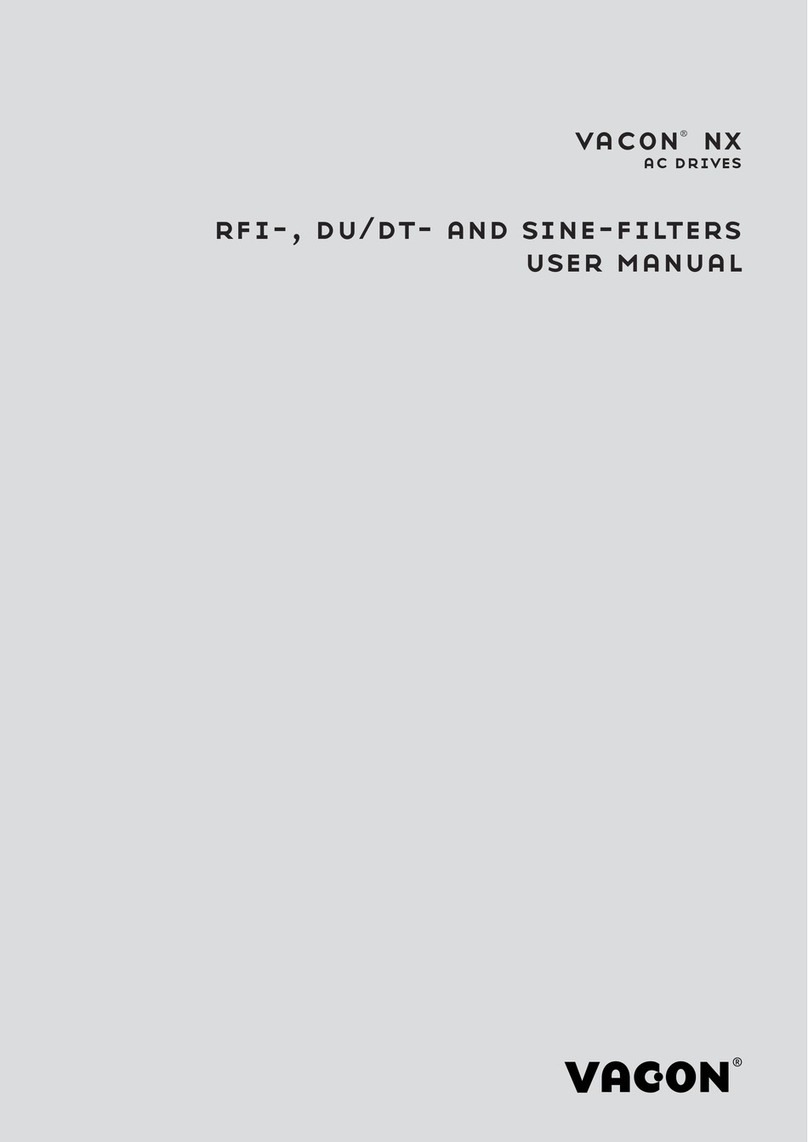
Vacon
Vacon RFI-0012-5-IP54 user manual
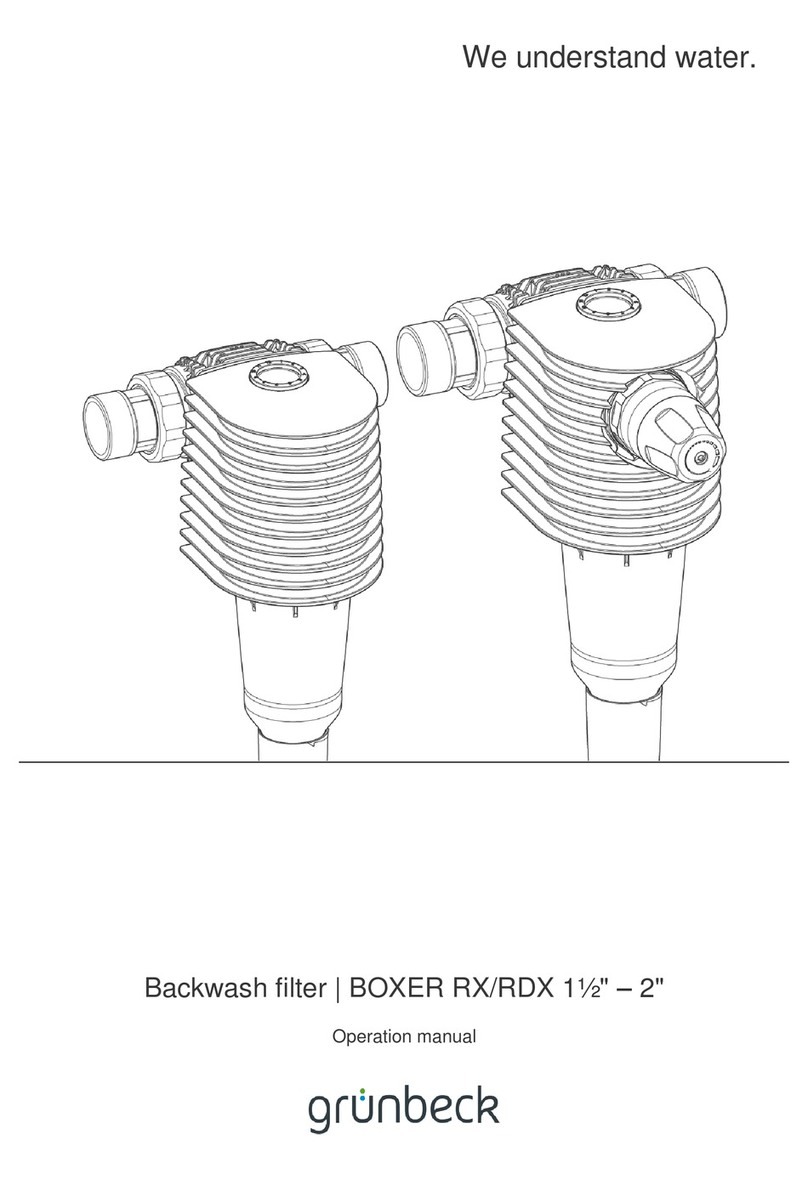
Grunbeck
Grunbeck BOXER RX 1 1/2 Operation manual
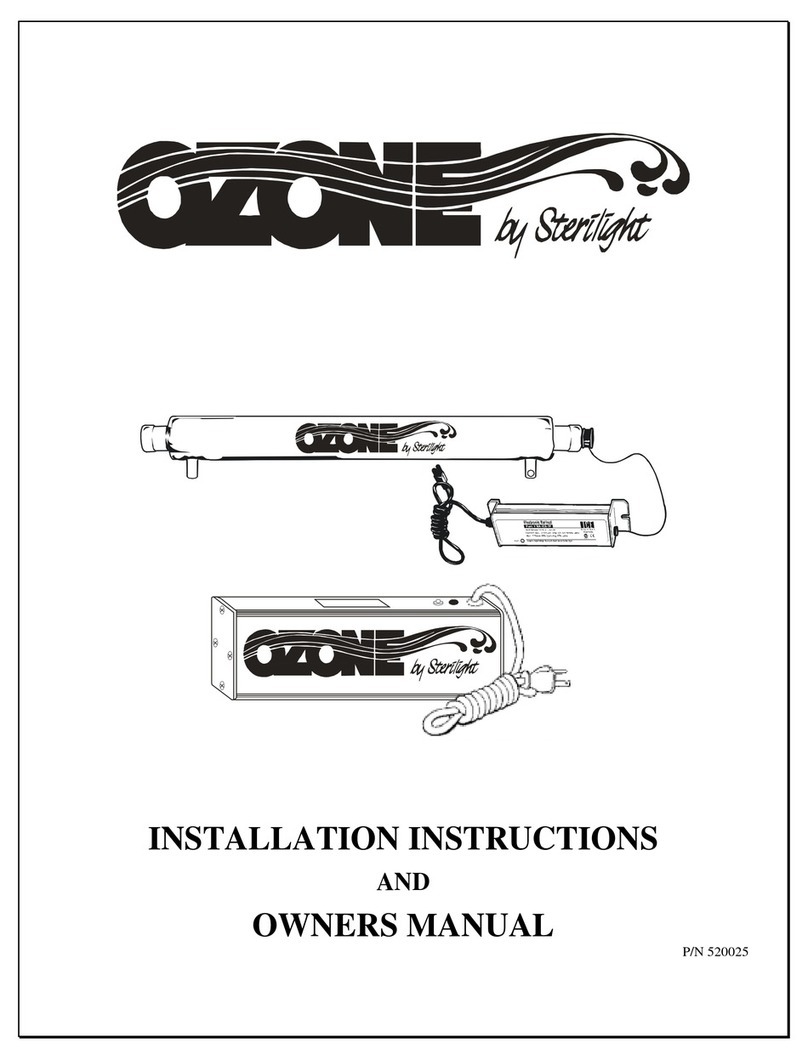
Sterilight
Sterilight Ozone S2ROZAP Installation instructions and owner's manual

US Water Systems
US Water Systems Big Blue installation guide

Waterdrop
Waterdrop WD-PT-04-42 owner's manual
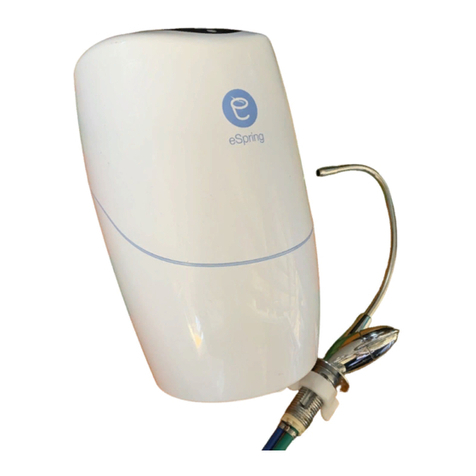
eSpring
eSpring 11-0192-CA owner's manual
